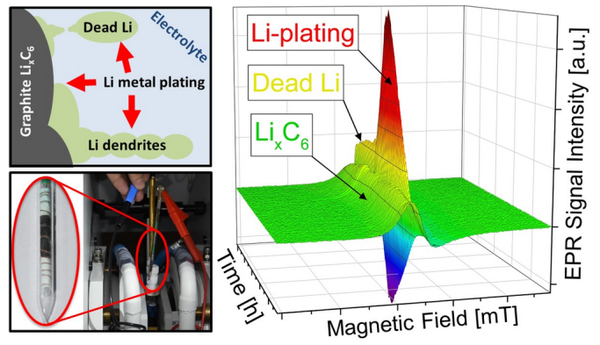Electron Spin Resonance
Electron spin resonance (EPR) generally detects paramagnetic centers. These can be simply described as unpaired electrons. There are many examples of this in nature. The origin of these unpaired electrons can be found in inorganic solids, among other things, as isolated oxygen vacancies or as doping with mainly 3d elements with different oxidation states in otherwise diamagnetic solids. Broken covalent bonds in polymers, called “dangling bonds,” can also produce unpaired electrons. Usually these electrons are localized. If these electrons can move as conduction electrons, e.g. in semiconductors, in metals such as lithium or with the help of polarons, the measurement result can differ significantly from local centers.
In operando EPR
To use different materials, several components are usually brought together. For example, a battery requires an anode, a cathode and a separator. The battery can then be “driven” to different states of charge (state of charge SOC) using different charging and discharging strategies. During this process, the components change and cannot be easily disassembled without destroying the structures.
Copyright:
-- Forschungszentrum Jülich GmbH / B. Wolff

For this reason, we use EPR for in operando measurements on lithium ion batteries and PEM fuel cells to record calendar (temporal) aging or fatigue caused by the load on the cell. Here, defects and oxidation states of the metal ions can be observed as they are formed reversibly or irreversibly [1]. The lithium ions can also be detected based on their conduction electrons as plated lithium in the different morphologies [2,3] (metal bodies, moss-like lithium or dendrites) on fully intercalated materials [4] or as so-called dead lithium, which occurs after deintercalation of lithium without electrical contact remains. Spins that cannot be measured because their states have a short lifespan can be made indirectly visible in this way using spin traps. This method is very common in EPR and is also used here, for example in PEM fuel cells or lithium-air cells [5]. It must be pointed out here that the detection of singlet oxygen in the case of the lithium-air cell is a selective reaction of the non-paramagnetic singlet oxygen with the also non-paramagnetic 4-oxo-TEMP to form a paramagnetic species 4 -Oxo-TEMPO acts [5].
EPR Imaging
Among other things, we use EPR for imaging at 9.5 GHz (X-band) and with two field gradient coils, which enable us to carry out 2D imaging, the image reconstruction of which is based on the same principles as computed tomography (CT) using Radon transformation. The sample systems we examine are lithium ion batteries and PEM fuel cells. In classic continuous wave EPR (c.w.-EPR), a signal is obtained which is ultimately composed of all paramagnetic centers of the sample, but without spatial resolution. The field gradients make it possible to make the origin of the EPR signals visible. In the case of lithium-ion batteries, we are interested in the growth of dendrites and mossy lithium, a structure that is characterized by a large surface area but unfortunately also brings with it many problems. 2D imaging can be expanded with spectral information (Spectral Spatial Imaging). In this way, the line shape of the EPR signal can be determined depending on the location. In the case of lithium, this can be used to draw conclusions about the local electrical conductivity, which, in addition to the local morphology, can be a reason why dendrites preferentially form there, which ultimately lead to a short circuit in the battery. In the case of fuel cells, local oxygen concentrations or local radical formations can be determined using imaging methods. This is currently under construction.
Equipment
There are a BRUKER ELEXSYS E780 (263 GHz), a BRUKER E580-10/12 (X/Q-band), a BRUKER E500+E540 (X-band+gradient coils), a BRUKER EMXplus (X-band), an ELEXSYS E500X and a BRUKER EMXnano Bench-Top EPR are available. In addition to the standard resonators, there is an X-band resonator with 20 mm opening, a goniometer for angle-dependent measurements and a high-temperature resonator (ER 4114HT-1000) up to 1200K.

